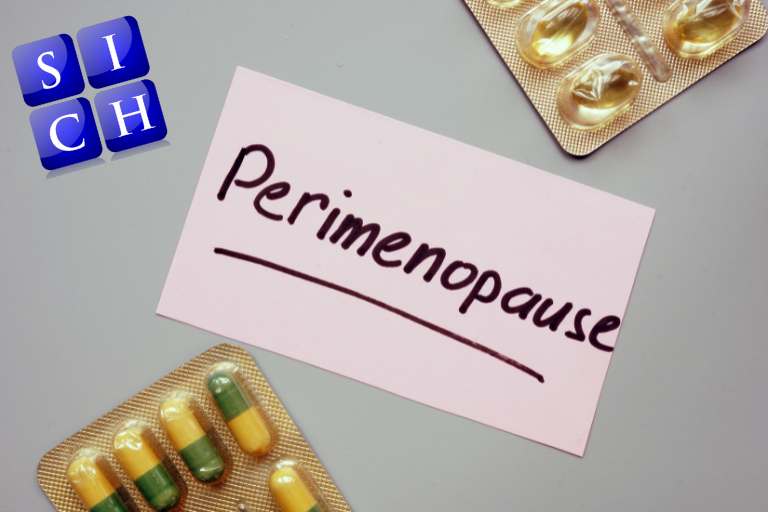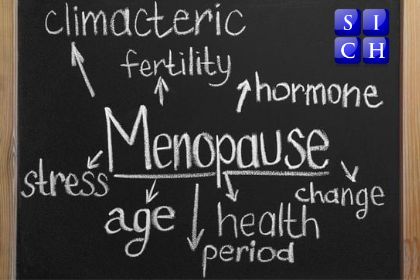The menopause transition is the transition phase between the reproductive stage and the menopausal phase. Also known as perimenopause, it usually starts in our 40s.
In the UK, the average age for menopause is 51 [1]. In this article, I will explain some of the signs perimenopause Is ending.
Table of Contents
Hormones’ role in women’s menstrual cycle

In our reproductive years, our menstrual cycles work on the fluctuations of different hormones, such as FSH (follicle-stimulating hormone), LH (luteinising hormone), oestrogen, and progesterone.
FSH and LH regulate the production of oestrogen during the cycle.
FSH turns on the follicles to produce oestrogen (follicles are fluid-filled sacs containing our ovaries). After achieving a specific oestrogen level, FSH is turned off and stimulates the production of LH. This helps the release of an egg from the ovary in the follicles.
The remaining follicles initiate the production of progesterone and reduce LH. So, when FSH and LH levels drop, oestrogen and progesterone rise. If pregnancy does not happen, progesterone reduces, and the menstrual cycle starts [2].
Perimenopause and hormones
In our reproductive years, oestrogen and progesterone levels stay stable. But as soon as we enter the menopausal transition phase, our progesterone levels start dropping, and our oestrogen levels fluctuate.
In the early stage, our oestrogen levels rise, while in late perimenopause, our oestrogen levels lessen. In menopause, both hormones lessen.
As we lose progesterone, we could experience higher oestrogen than ever, up to three times higher, which can cause symptoms such as irritable mood, breast pain, and heavy periods [3].
Stages of perimenopause
According to researchers, perimenopause follows four stages:
The first stage is ‘early perimenopause’ (periods are still fairly regular), followed by the ‘early menopause transition’ (the start of irregular periods). We then have ‘late menopause transition’ (60 days without a period), followed by ‘late perimenopause’ (12 months from your last period).
We then have one day of menopause and after that we become postmenopausal.
The major hormones that our ovaries produce, oestrogen and progesterone, are responsible for all stages in the menstrual cycle, from reproductive cycles to menopause.
As we age, the production of these hormones fluctuates greatly in the ovaries. Early perimenopause usually starts between 35 to 50 years. Late perimenopause occurs in the 40s to 50s.
During the length of perimenopause, the levels of oestrogen and progesterone may be greater or lesser than usual. And the signs perimenopause is ending are due to these hormones.
Symptoms in different stages of perimenopause
Stage 1
In the first stage, the body shows small alterations in our menstrual cycle, along with a slight variation in energy levels.
We may feel breast tenderness, anxiety, headaches, and disturbed sleep at a minimum level. Losing weight may also be a challenge at this point. The menstrual cycle may reduce a little, along with heavy periods and pain.
Stage 2
Stage 2 leads to more hot flushes. At this stage, our oestrogen also lowers, along with our progesterone. This stage is indicated by a more significant variation in the menstrual cycle.
Stage 3
Once we have had no periods for 60 days, this is the late perimenopausal stage.
Low oestrogen and progesterone cause worse hot flushes and night sweats. The periods are usually heavy. But the good news is that breast tenderness will start reducing.
Stage 4
Stage 4 is the official end of perimenopause and the start of menopause. There are no periods for 12 months. Fluctuations in hormones begin to settle down, and the body is now used to low oestrogen levels. That’s why the symptoms that have greatly disturbed women’s lives in perimenopause, start to disappear.
Stage 1 lasts for around 2 to 5 years, while stage 2 and stage 3 shift from skipped periods to the last period of life, and these stay for around 3 to 5 years. The last stage is the initiation of menopause, it takes one year from the last period to menopause [3].
Perimenopausal symptoms are due to oestrogen and progesterone
Higher oestrogen levels may cause bloating, cramping, heavier bleeding, and breast tenderness. At the same time, lower oestrogen levels may cause vaginal dryness, insomnia, hot flushes, night sweats, headaches, fatigue, thinning of the uterine lining, and osteoporosis.
The symptoms of perimenopause mainly arise due to low progesterone. Low progesterone brings symptoms such as sore breasts, irregular heartbeat, night sweats, headaches, and heavy period flow. Less progesterone also causes a rise in oestrogen levels that may be three times greater than usual and is responsible for many of our perimenopausal symptoms [5].
Signs that perimenopause is ending
After the roller coaster of hormones, there is eventually, an end and that is menopause.
Before we hit menopause, there are some tell-tale signs perimenopause is ending. These signs include the following:
Irregular periods start
Irregular periods are common perimenopausal symptoms. Fluctuations in our menstrual bleeding and length are because of changes in our oestrogen levels. The more extended periods shift to missing periods. If there are no periods for 60 days, then it is a strong sign that the perimenopause is ending and there is the official beginning of menopause [6].
Hot flushes increase
Hot flushes, a common perimenopausal symptom, is also another one of the aggressive signs that the perimenopause Is ending.
At the end of perimenopause, our progesterone levels drop even more. And so, the hot flushes increase. A dose of progesterone, when given in a form that is identical to the natural hormone, can help to minimise hot flushes. Dr. Prior, professor of endocrinology and metabolism at the University of British Columbia, Vancouver, has proven the efficacy of progesterone to improve the symptoms in a 12-week study [4].

In addition, lower oestrogen also triggers more hot flushes.
Oestrogen is essential in our temperature regulatory mechanisms, and that is why our body’s thermoregulation mechanism is also disturbed when levels drop.
Mood swings improve
As perimenopause ends, our fluctuating hormones stabilise at a lower level.
The North American Menopause Society has stated that 75% of women experience mood swings in their menopausal transition phase. Menopause can also bring depression and anxiety. The associated symptoms of perimenopause, such as trouble sleeping, night sweats, and other physical issues of the midlife mechanism, can cause emotional distress that can badly affect our mood. Another of the signs perimenopause Is ending is our fluctuating hormones begin to stabilise, along with the mood swings [8].
Headache reduction
Hormonal headaches are a common symptom of perimenopause, because of those fluctuating hormones. Once the hormones start settling down at the end of perimenopause, the episodes of hormonal headaches also reduce. It is one of the good signs perimenopause is ending [9].
Sleep improves
Fluctuating hormones and associated symptoms, like hot flushes and increased irritability, can also cause sleep problems.
At the end of perimenopause, hot flushes increase along with night sweating. Other physical issues, anxiety and depression also disturb our sleep patterns, and many women can experience insomnia.
Fatigue
Poor sleep and increased hot flushes can make you feel exhausted during the day. Insomnia and night sweats disturb our sleep, and when we wake up, we can feel like we haven’t slept.
Other physical changes also bring irritability and disturbed sleep patterns. All these factors can cause extreme fatigue.
Vaginal dryness
As perimenopause moves towards its end, our oestrogen declines even more. Vaginal dryness becomes a problem, and the vaginal area may be itchy and sore, which can cause pain and discomfort during sex. Vaginal dryness, unlike other temporary symptoms of perimenopause, continues into menopause and postmenopause [7].
All in all, there are a variety of perimenopausal symptoms that affect every woman differently. Even the signs perimenopause is ending differ in severity.
Once you miss your periods for 60 days, it means you are in late perimenopause stage which is another of the signs perimenopause is ending. And if there are no periods for a consecutive 12 months, we then hit menopause (which is literally only one day), we are then postmenopausal.
References:
References for – signs perimenopause Is ending
- Understanding Menopause. (n.d.). My Menopause Centre. https://www.mymenopausecentre.com/knowledge/menopause-explained/
- Perimenopause: Rocky road to menopause – Harvard Health. (2009, June 9). Harvard Health. https://www.health.harvard.edu/womens-health/perimenopause-rocky-road-to-menopause
- https://www.larabriden.com/sample/hrm-ch1-2.pdf
- Elletson, S. (2022, April 6). The four stages of perimenopause. FUTURE WOMAN. https://future-woman.com/four-stages-perimenopause/
- Perimenopause and Ovary Pain: Causes, Symptoms, and Treatments. https://www.medicalnewstoday.com/articles/322040
- Ltd, J., & Team, T. G. (n.d.). Manage the stages of perimenopause and understand how long you can expect perimenopause to last. – GlycanAge. Manage the Stages of Perimenopause and Understand How Long You Can Expect Perimenopause to Last. – GlycanAge. https://glycanage.com//self-care/menopause/how-long-does-perimenopause-last
- Progesterone Alone May Help Hot Flashes. (2010, June 22). WebMD. https://www.webmd.com/menopause/news/20100622/progesterone-alone-may-help-hot-flashes
- Depression, Mood Swings, Anxiety, Sexual Side Effects of Menopause | the North American Menopause Society, NAMS. https://www.menopause.org/for-women/sexual-health-menopause-online/causes-of-sexual-problems/depression-mood-swings-anxiety
